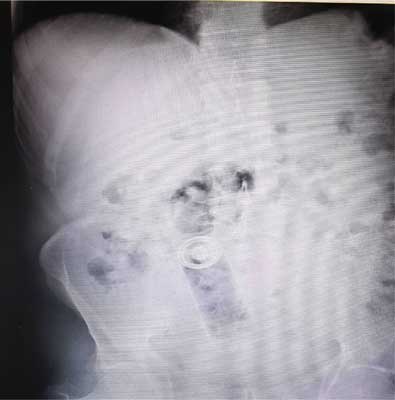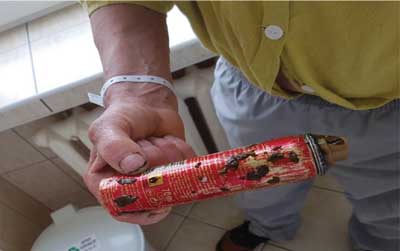*Szymon Głowacki, Tomasz Pokładowski, Karol Łukasiak, Zbigniew Suwała, Katarzyna Krasińska
Foreign body in the rectum – a case report
Ciało obce w odbytnicy – opis przypadku
Department of Surgery, Independent Public Complex of Health Care Facilities, Sierpc
Head of Department: Szymon Głowacki, MD, PhD
Streszczenie
Chorzy z ciałem obcym w odbytnicy zgłaszają się do lekarza zwykle późno ze względu na wstyd i seksualny aspekt urazu. Różnorodność przedmiotów, ich wielkość oraz czas przebywania w jelicie mogą być przyczyną powikłań miejscowych lub ogólnych, które mogą skończyć się kalectwem, a nawet zgonem pacjenta. Próby wyjęcia ciała obcego wiążą się z różnymi technikami, endoskopią zabiegową czy, w ostateczności, leczeniem operacyjnym. Najtrudniejsze do usunięcia są ciała owalne, twarde, które łatwo przemieszczają się proksymalnie do wyższych odcinków jelita.
Autorzy prezentują przypadek pacjenta, który zgłosił się na ostry dyżur z powodu bólów brzucha i zaparcia, wynikającego z uwięźnięcia ciała obcego w odbytnicy. Ciało obce – dezodorant – zostało włożone do odbytnicy ok. 3 dni wcześniej w trakcie perwersji seksualnej. Podjęto nieskuteczną próbę usunięcia ciała obcego przez odbyt w warunkach bloku operacyjnego i sedacji pacjenta. Po podaniu preparatu Fortrans pacjent samodzielnie wydalił ciało obce. Po dobowej obserwacji pacjenta wypisano do domu w stanie ogólnym i miejscowym dobrym. Autorzy pragną podkreślić rolę preparatów czyszczących używanych do przygotowania do kolonoskopii jako alternatywy dla zabiegów wydobycia ciała obcego w sedacji.
Summary
Patients with foreign bodies in the rectum usually report late to the doctor due to embarrassment and the sexual nature of the injury. The variety of objects, their size and time from insertion may cause local or systemic complications, which can result in disability or even death of the patient. Attempts to remove a foreign body involve the use of different techniques, such as invasive endoscopy or, as a last resort, surgical treatment. Hard, oval objects which easily move proximally to the upper intestinal segments are most difficult to retrieve.
We present a case of a patient who reported to the emergency room due to abdominal pain and constipation caused by foreign body entrapment in the rectum. The foreign body, a deodorant bottle, was inserted into the rectum about three days earlier as a part of sexual perversion. An unsuccessful transanal retrieval of the foreign body was attempted in the operating setting with the use of sedation. Ultimately, the patient excreted the object following the administration of Fortrans. He was discharged home in good local and general condition after a 24-hour follow-up. We wish to emphasise the role of bowel cleansing agents used for colonoscopy as an alternative for foreign body extraction procedures performed under sedation.

Introduction
Foreign bodies in the rectum/large intestine are rarely encountered in medical practice. Patients usually report late to the doctor due to embarrassment and the sexual nature of the injury. The mechanism for a foreign body entering the intestine may involve ingestion (fishbone, chicken bone) or direct insertion into the rectum (1). The problem usually concerns men (often homosexual) aged between 18 and 90 years. A foreign body can be introduced into the anal canal during sexual practices or sexual assault. This may also happen in an attempt to massage the prostate or as a result of an enema nozzle left accidentally in the rectum after an attempt to remove faecal masses in patients with constipation (2). The variety of objects, their size and time from insertion may cause local or systemic complications, which can result in disability or even death of the patient (3). Attempts to remove a foreign body involve the use of different techniques, such as invasive endoscopy or, as a last resort, surgical treatment (4). We wish to emphasise the role of bowel cleansing agents used for colonoscopy as an alternative for foreign body extraction procedures performed under sedation.
A case report
A 60-year-old patient under the influence of alcohol reported to the hospital due to abdominal pain, constipation and impaired urination. The patient reported that he participated in a sexual adventure 3 days earlier, when a deodorant bottle was inserted into his rectum. Physical examination revealed soft abdomen, a palpable resistance in the lower abdomen with local muscular defence, negative peritoneal symptoms. Laboratory findings revealed increased inflammatory parameters. Plain abdominal X-ray showed a foreign body in the distal sigmoid/rectum (fig. 1). The patient was qualified for divulsion and transanal retrieval under sedation. The attempt was unsuccessful. The patient was offered surgical treatment to which he gave no consent. A decision was made to administer bowel cleansing preparation for colonoscopy (Fortrans). After receiving the second sachet diluted in 1 litre of water, the foreign body (a deodorant bottle) was excreted (fig. 2).

Fig. 1. A foreign body in the large intestine – abdominal X-ray

Fig. 2. The foreign body removed from the rectum
The patient remained in the ward for a 24-hour follow-up. He had no abdominal pain, no signs of perforation or bleeding. The patient was discharged home in good condition with instructions for an outpatient follow-up.
Discussion
Powyżej zamieściliśmy fragment artykułu, do którego możesz uzyskać pełny dostęp.
Mam kod dostępu
- Aby uzyskać płatny dostęp do pełnej treści powyższego artykułu albo wszystkich artykułów (w zależności od wybranej opcji), należy wprowadzić kod.
- Wprowadzając kod, akceptują Państwo treść Regulaminu oraz potwierdzają zapoznanie się z nim.
- Aby kupić kod proszę skorzystać z jednej z poniższych opcji.
Opcja #1
29 zł
Wybieram
- dostęp do tego artykułu
- dostęp na 7 dni
uzyskany kod musi być wprowadzony na stronie artykułu, do którego został wykupiony
Opcja #2
69 zł
Wybieram
- dostęp do tego i pozostałych ponad 7000 artykułów
- dostęp na 30 dni
- najpopularniejsza opcja
Opcja #3
129 zł
Wybieram
- dostęp do tego i pozostałych ponad 7000 artykułów
- dostęp na 90 dni
- oszczędzasz 78 zł
Piśmiennictwo
1. Coskun A, Erkan N, Yakan S et al.: Management of rectal foreign bodies. World J Emerg Surg 2013; 8: 11.
2. Kasotakis G, Roediger L, Mittal S: Rectal foreign bodies: a case report and review of the literature. Int J Surg Case Rep 2012; 3(3): 111-115.
3. Kurer MA, Davey C, Khan S, Chintapatla S: Colorectal foreign bodies: a systematic review. Colorectal Dis 2010; 12(9): 851-861.
4. Koomstra JJ, Weersma RK: Management of rectal foreign bodies: description of a new technique and clinical practice guidelines. World J Gastroenterol 2008; 14(27): 4403-4406.
5. Goldberg JE, Steele SR: Rectal foreign bodies. Surg Clin North Am 2010; 90: 173-184.
6. Clarke DL, Buccimazza I, Anderson FA, Thomson SR: Colorectal foreign bodies. Colorectal Dis 2005; 7: 98-103.
7. Cohen JS, Sackier JM: Management of colorectal foreign bodies. J R Coll Surg Edinb 1996; 41(5): 312-315.
8. Humes D, Lobo DN: Removal of a rectal foreign body by using a Foley catheter passed through a rigid sigmoidoscope. Gastrointest Endosc 2005; 62(4): 610.
9. Billi P, Bassi M, Ferrara F et al.: Endoscopic removal of a large rectal foreign body using a large balloon dilator: report of a case and description of the technique. Endoscopy 2010; 42: E238.
10. Rodríguez-Hermosa JI, Codina-Cazador A, Ruiz B et al.: Management of foreign bodies in the rectum. Colorectal Dis 2007; 9(6): 543-548.
11. Lake JP, Essani R, Petrone P et al.: Management of retained colorectal foreign bodies: predictors of operative intervention. Dis Colon Rectum 2004; 47(10): 1694-1698.



